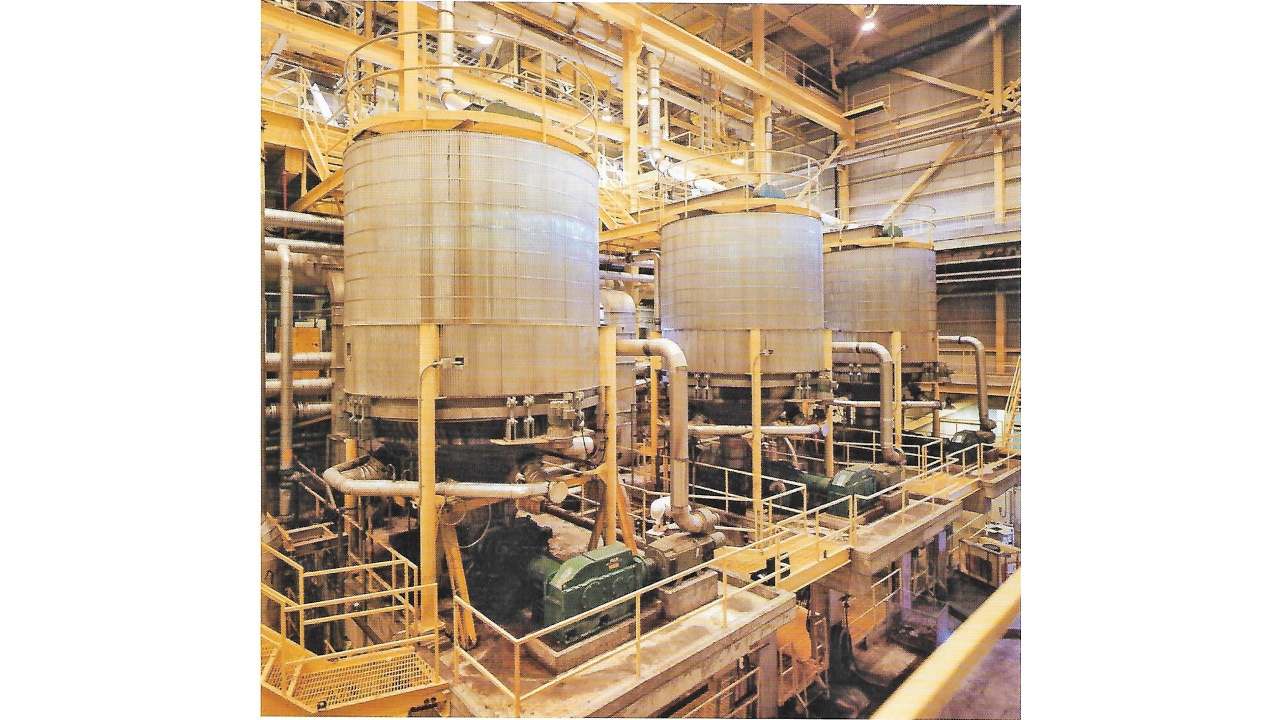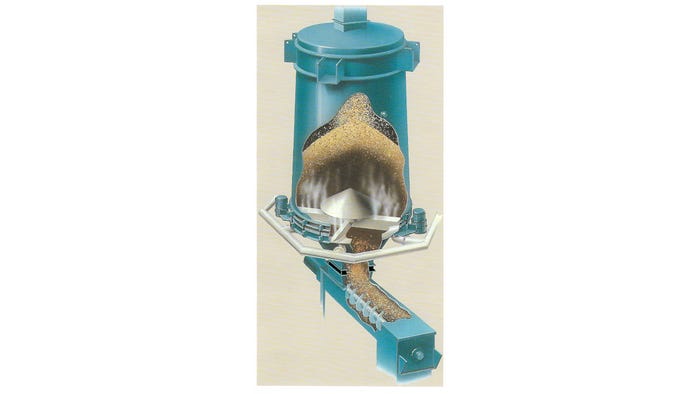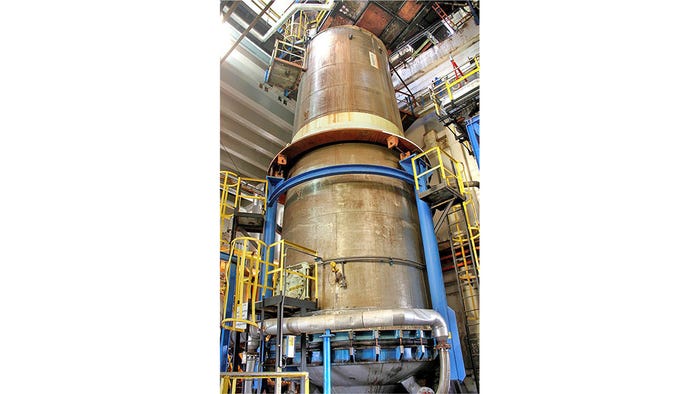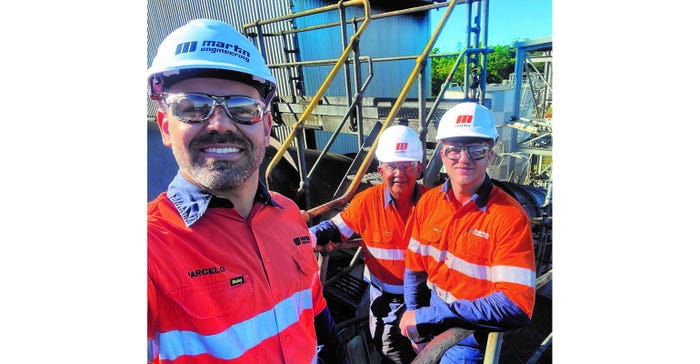Perfect Wood Chip Flow and Pre-Steaming EfficiencyPerfect Wood Chip Flow and Pre-Steaming Efficiency
The bin activator is an indispensable piece of equipment in wood products production.
February 20, 2025

Wood chips are one of the most difficult bulk materials to discharge from storage. The bin activator is an indispensable piece of equipment in wood products production. Wood chip pre-steaming is a crucial step in wood products processing, particularly in pulp and paper manufacturing, biomass energy production, and engineered wood products. The pre-steaming process ensures uniform moisture distribution, removes air from wood pores, and prepares chips for subsequent treatments such as chemical impregnation or mechanical refining. However, effective handling of wood chips within pre-steaming bins poses significant challenges due to material bridging, arching, and flow inconsistencies. This is where Bin Activators play a critical role in ensuring smooth material discharge and process efficiency.
Understanding Bin Activators
Bin activators are specialized discharge devices installed at the bottom of storage bins, silos, or hoppers. Their primary function is to facilitate the consistent flow of bulk materials by breaking up compaction, preventing blockages, and ensuring a controlled discharge rate. Bin activators typically consist of a vibratory motor, suspension system, and specific internal geometry that assists in reducing material buildup. Wood chips require bin activators that are sized nearly as large as the bin diameter. Bin activators are built up to 18 ft in diameter to ensure proper sizing.

16-ft steamer bin activator with chip meter screw running at 520 tn/day (Vibra Screw Inc.)
Challenges in Wood Chip Pre-Steaming Systems
1. Material Flow Issues
Wood chips--being fibrous and irregularly shaped--tend to interlock and form cohesive masses, leading to flow restrictions in bins. Without proper flow management, chips may form stagnant zones, affecting steaming efficiency and overall process continuity.
2. Arching & Bridging
Arching occurs when wood chips form a self-supporting structure above the bin outlet, preventing further discharge. Bridging refers to interlocked particles forming a blockage in the upper bin, leading to process interruptions and downtime
3. Inconsistent Steam Penetration
Non-uniform material movement results in uneven steam distribution, causing variations in moisture content. This can negatively impact subsequent processes such as pulping, refining, or combustion in biomass applications.
4. Material Degradation
Excessive mechanical handling to rectify flow issues can lead to wood chip degradation, generating fines and dust. This is undesirable, as fine particles affect process efficiency and may lead to safety hazards like dust explosions.

14-ft-diam pre-steaming bin activator mounted on revers slope bin (Vibra Screw Inc.)
The Role of Bin Activators in Wood Chip Pre-Steaming Systems
Bin activators address the above challenges by enhancing material discharge, promoting uniform steaming, and ensuring consistent downstream processing. Their implementation in pre-steaming systems offers numerous benefits:
1. Enhanced Material Flow
The vibratory action of bin activators breaks up compaction and prevents interlocking, allowing wood chips to flow freely through the bin. This eliminates the risk of stagnant zones and ensures that the pre-steaming process remains uniform.
2. Prevention of Arching and Bridging
By applying controlled vibrations, bin activators disrupt cohesive forces and prevent material arching or bridging. This ensures continuous material movement without the need for manual intervention or additional mechanical agitators.
3. Uniform Steam Distribution
Consistent material discharge facilitated by bin activators results in even exposure to steam. This is crucial for achieving uniform moisture penetration, reducing variability in downstream processes, and improving overall efficiency.
4. Improved Process Efficiency
The automation of material discharge minimizes manual intervention, reduces downtime, and ensures a steady feed to subsequent processing stages. This leads to enhanced process stability and increased throughput.
5. Reduction in Material Degradation
Unlike aggressive mechanical agitation methods, bin activators use controlled vibrations to promote flow, minimizing the generation of fines and preserving the integrity of wood chips. This is especially important for maintaining optimal chip quality in applications such as pulp production and biomass combustion.
Design Considerations for Bin Activators in Wood Chip Pre-Steaming Systems
To maximize the effectiveness of bin activators, several design factors must be considered:
1. Proper Sizing
The bin activator must be appropriately sized based on the storage bin’s diameter and the required discharge rate. Undersized units may not provide sufficient force to promote flow.
2. Integration with Steam Injection
To further optimize pre-steaming, bin activators are equipped with steam supply connections. Manifolds carry steam to strategically located injection points. This ensures that wood chips receive consistent steaming while being discharged, enhancing the overall efficiency of the process.
3. Vibratory Motor Selection
The choice of vibratory motor influences the intensity and frequency of vibrations. Motors must be selected based on wood chip characteristics, material loading, bin dimensions, and required material flow rates.
4. Suspension System
A well-designed suspension system safely supports the bin activator and ensures effective energy transfer while minimizing structural stress on the bin. Flexible rubber or steel cable suspensions are commonly used to enhance durability and vibration efficiency.
5. Internal Geometry
The shape and angle of internal baffling and outlet cones impact material discharge behavior. Proper geometry minimizes dead zones and promotes even material flow, reducing the likelihood of blockages.
Case Studies: Successful Implementation of Bin Activators
Case Study 1: Pulp & Paper Industry
A leading pulp mill faced frequent material flow issues in its pre-steaming bins, leading to inconsistent steaming and process disruptions. By installing Bin Activators at the discharge points, the mill eliminated bridging problems, achieved uniform steam penetration, and improved chip quality. This resulted in higher efficiency and reduced energy consumption.
Case Study 2: Biomass Energy Production
A biomass power plant experienced clogging issues in its wood chip storage bins, affecting feed consistency to the combustion chamber. The implementation of bin activators ensured steady discharge, reducing manual intervention and enhancing boiler performance. This led to improved combustion efficiency and increased power output.
Case Study 3: Engineered Wood Products
A manufacturer of particleboard and MDF panels encountered inconsistent wood chip feeding in its pre-steaming process, causing variability in panel quality. Bin activators were installed to stabilize material flow, leading to uniform moisture distribution and improved product consistency. The company reported significant reductions in material waste and production downtime.
Maintenance & Operational Best Practices
To ensure the long-term reliability of bin activators, regular maintenance and proper operation are essential:
1. Routine Inspections
Periodic checks of vibratory motors, suspension systems, and outlet cones help identify potential issues before they cause operational disruptions.
2. Vibration Monitoring
Monitoring vibration levels ensures that the Bin Activator operates within optimal parameters. Unusual vibrations may indicate misalignment, motor wear, or mounting issues.
3. Lubrication and Component Replacement
Proper lubrication of motor bearings and timely replacement of worn components extend the lifespan of bin activators and prevent unexpected failures.
4. Integration with Automated Controls
Incorporating bin activators into automated control systems allows for real-time monitoring and adjustment of vibration intensity, optimizing material flow based on process demands.
Conclusion
Bin activators play an indispensable role in enhancing the efficiency of wood chip pre-steaming systems. By ensuring consistent material discharge, preventing flow disruptions, and promoting uniform steam penetration, they contribute to improved process stability and product quality. When properly designed, installed, and maintained, bin activators can significantly enhance the overall performance of wood-based industries, reducing downtime, increasing throughput, and optimizing resource utilization. As advancements in material handling technology continue, Bin Activators will remain a vital component in modern wood chip processing operations.
Tom Picone is director of business development at Vibra Screw Inc. (Totowa, NJ), a manufacturer of material handling equipment including loss-in-weight feeders, weigh belts screw feeders and bin dischargers. A graduate of Fairleigh Dickinson University, Picone has more than 39 years of experience in the material handling industry. For more information, call 973-256-7410, email [email protected], or visit www.vibrascrew.com.
About the Author
You May Also Like


